Key takeaways:
- Journal metrics, such as Impact Factor and h-index, provide quantitative measures of academic influence but should not solely define the quality of scholarly work.
- Understanding the context and community surrounding a journal is crucial, as metrics can vary significantly across different fields and may overlook valuable contributions.
- Engaging with editorial teams and considering community perceptions can enhance the evaluation of journals beyond numerical data, encouraging a more holistic approach to publication decisions.
- Metrics should be used as a guiding tool in publication choices, weighing the journal’s character and relevance alongside traditional metrics.
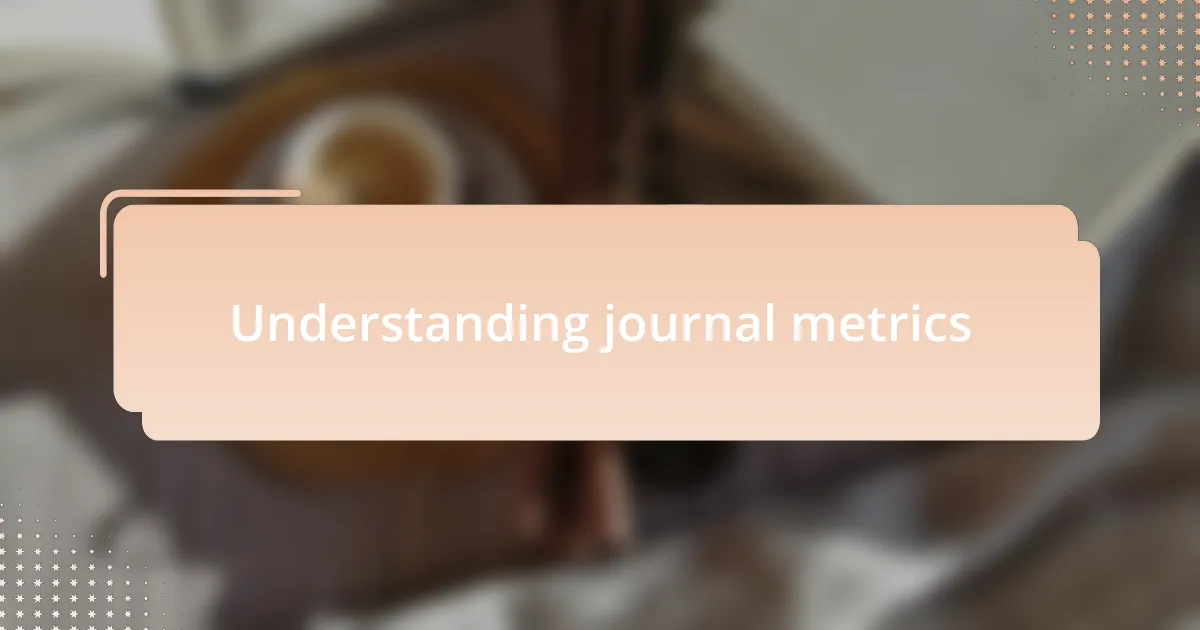
Understanding journal metrics
Journal metrics play a vital role in assessing the influence and quality of academic journals. When I first encountered these metrics, I was fascinated by how they provide a quantitative measure of a journal’s impact. It’s interesting to think about how numbers can encapsulate a journal’s reputation and reach.
One metric that often comes up is the Journal Impact Factor (JIF). Initially, I was skeptical about its reliability; it felt too simplistic to capture the nuances of scholarly contributions. But over time, I realized that while the JIF can highlight popular journals, it doesn’t tell the whole story about the quality of the research published within them.
Another crucial aspect to consider is the h-index, which reflects both the productivity and citation impact of an author or journal. I remember when I was analyzing my own publication output, and it was enlightening to witness how this measure illustrated the connection between my work and its reception in the academic community. This raised a question for me: can a single metric truly define the value of scholarly work? The answer seems to lie in understanding that metrics are just one tool among many.

Importance of journal metrics
Journal metrics are essential tools for evaluating the overall impact of scholarly journals, shaping the decisions of researchers, libraries, and funding agencies. I remember when I was searching for a publication venue for my research; referencing these metrics not only informed my choices but also gave me a sense of direction in a crowded academic landscape. It made me wonder: how can we expect to navigate the complexities of academic publishing without quantifiable benchmarks?
The importance of metrics extends beyond just choosing where to publish; they also serve as a means for researchers to demonstrate the credibility of their work. I vividly recall presenting my findings to a committee, and when I highlighted the metrics associated with the journals where my articles were published, there was a notable shift in their perception of my research’s validity. It struck me then how these numbers can amplify a scholar’s voice in a competitive environment.
Furthermore, metrics can identify trends in research fields, revealing which areas are growing or diminishing in interest. Observing shifts in these metrics, I began to understand the ebb and flow of academic conversations. This made me curious about how our research pursuits can align with these trends for greater relevance. Ultimately, these metrics are like guiding stars, directing us toward impactful academic contributions.
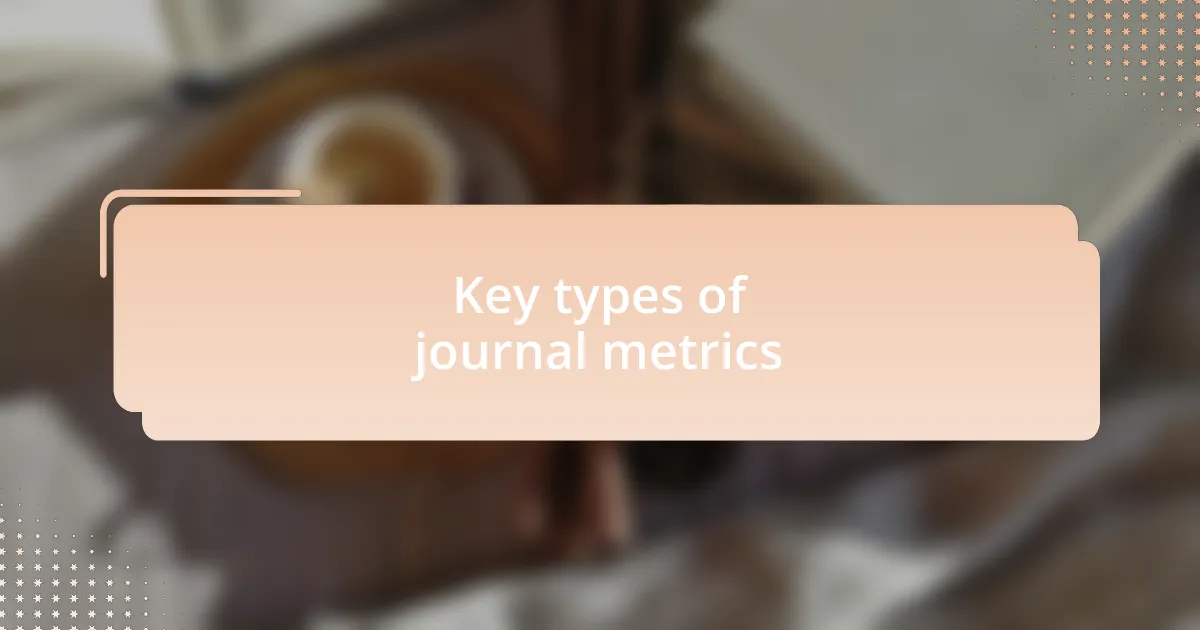
Key types of journal metrics
One key type of journal metric is the Impact Factor, which measures the average number of citations to articles in a journal over a specific time frame. I remember my initial excitement when I discovered how this metric could instantly elevate a journal’s status, making it seem essential for my own work. Seeing journals with high Impact Factors made me question: is citation really the best measure of worth, or are there other dimensions we need to consider?
In addition to Impact Factor, there is the h-index, which evaluates both the productivity and citation impact of an individual researcher or journal. When I first learned about the h-index, it felt empowering; it quantified my contributions in a way that felt more holistic. It prompted me to ask, how can we balance the desire for quantity in publications with the importance of quality, and can metrics like the h-index offer that balance?
Lastly, Altmetrics present a modern twist, focusing on the online attention a research article receives—think social media mentions and downloads. I was surprised to discover how much traction my work gained outside traditional citation metrics on platforms like Twitter and ResearchGate. This experience led me to reflect: is the scholarly community ready to embrace these new metrics, and how might they reshape our understanding of a journal’s influence in our increasingly digital world?
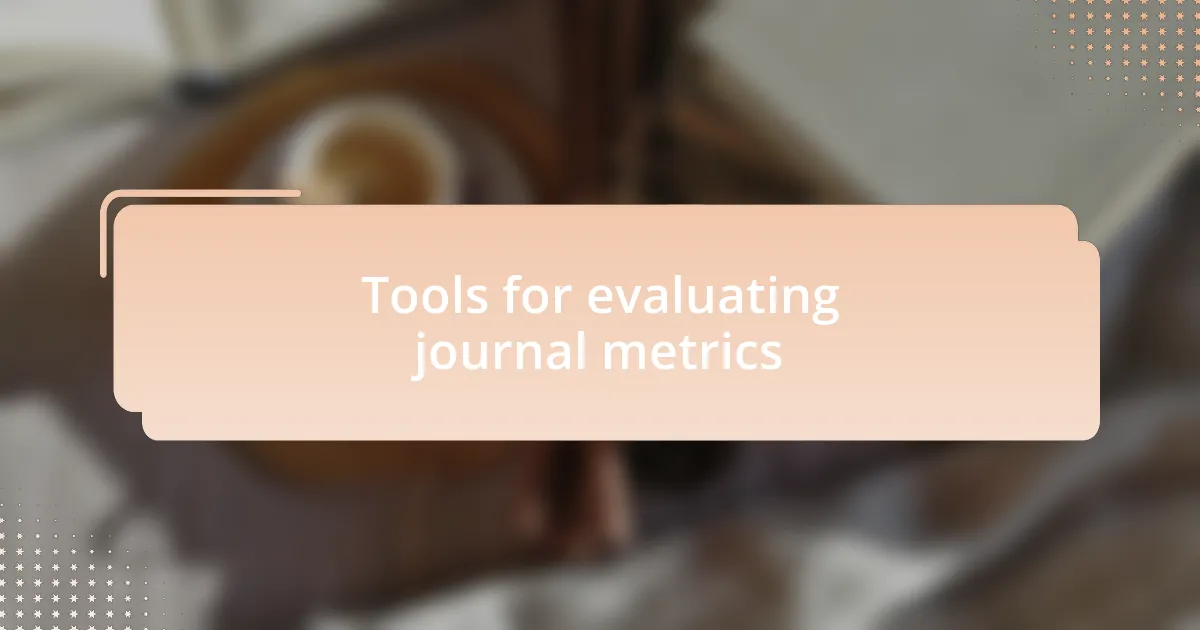
Tools for evaluating journal metrics
When it comes to tools for evaluating journal metrics, one that stands out in my experience is Journal Citation Reports (JCR). This resource allowed me to dive deep into the Impact Factor of various journals, and I remember feeling a sense of clarity as I compared different metrics. It was like holding a magnifying glass to the publication landscape—how often I turned to JCR to make informed decisions about where to submit my work.
Another invaluable tool is Scopus, which offers a comprehensive citation database alongside metrics like the CiteScore. I found the interface user-friendly, making it easy to analyze trends over time. Have you ever wondered how some journals maintain their prestige? After spending hours sifting through the data in Scopus, I began to see patterns that helped me understand the underlying factors contributing to a journal’s reputation.
Lastly, Google Scholar Metrics provides an accessible way to gauge the h-index of journals. I once used it to evaluate a lesser-known journal, and to my surprise, its h-index rivaled some highly regarded publications. This experience made me reconsider my biases: could there be hidden gems in the academic publishing world that deserve recognition beyond traditional metrics? Engaging with these tools has not only informed my choices but also sparked a curiosity about the diversity of academic output.
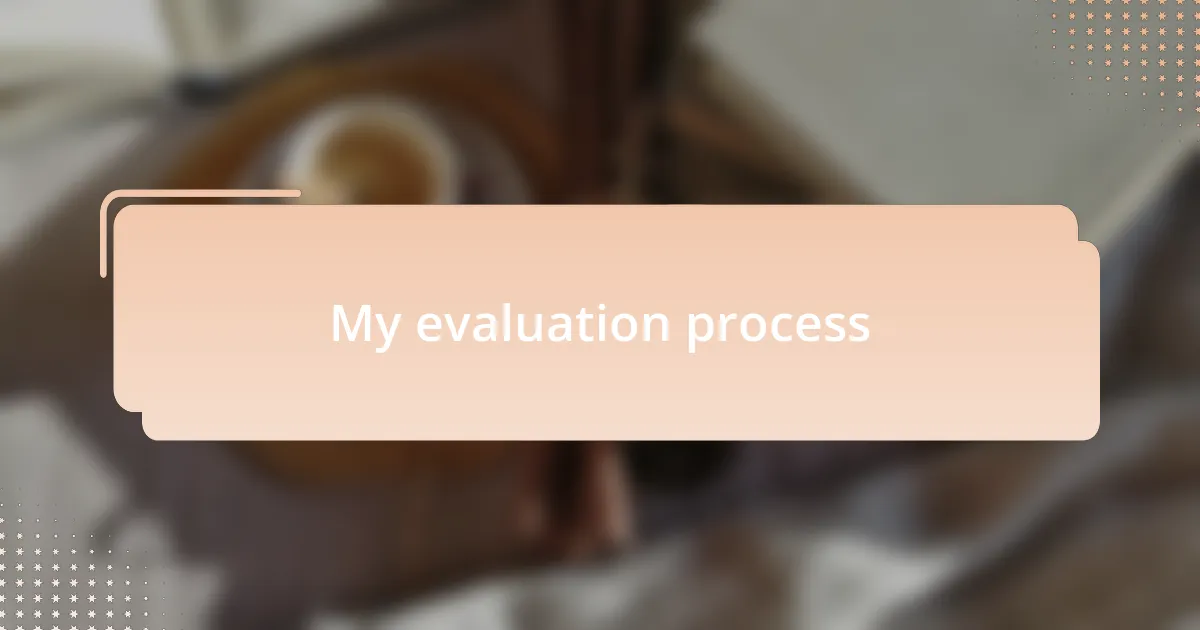
My evaluation process
As I embarked on my journey evaluating journal metrics, I made sure to consult multiple sources to gain a well-rounded view. One particularly memorable moment occurred when I stumbled upon a niche journal that, despite its modest Impact Factor, had a passionate community of scholars. This discovery prompted a reflection on the value of engagement within a field—sometimes, the academic conversation is just as crucial as numerical scores.
Throughout my evaluation process, I meticulously tracked each journal’s growth over time, noting how metrics could fluctuate with shifting editorial policies or external influences. One day, while poring over Scopus data, I realized that the trends not only revealed a journal’s stability but also hinted at its evolving scholarly impact. This led me to ask myself: how often do we overlook the nuances behind the numbers? I now appreciate that each metric tells a story waiting to be uncovered.
In another instance, I engaged with a journal’s h-index firsthand, intrigued by how it could reflect both the volume and significance of published research. When I saw a growing h-index alongside an increase in innovative research outputs, I couldn’t help but feel enthusiastic about the potential contributions to the field. Evaluating these metrics is not just a numbers game; it feels like being part of an intricate narrative in academic publishing, where every decision shapes the broader conversation.
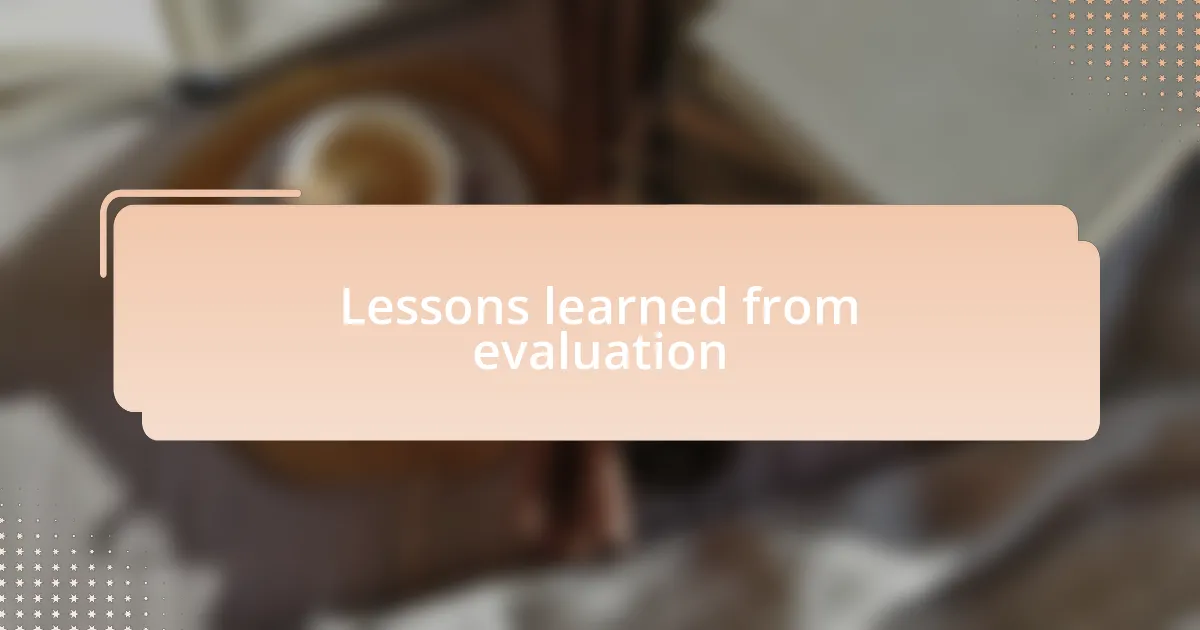
Lessons learned from evaluation
As I progressed in my evaluation, I learned that metrics alone don’t paint the entire picture. There was a journal I initially dismissed due to its modest rankings but later discovered the passionate discourse it fostered. It made me wonder—how many other hidden gems are we missing because we focus solely on numbers?
One key lesson was the importance of contextualizing metrics within their specific fields. While analyzing a journal’s citation trends, I found that its impact varied dramatically depending on its area of study. This variability led me to realize that a metric’s value can shift significantly based on the community it serves, emphasizing the need for a tailored approach to evaluation.
Additionally, engaging directly with editorial teams opened my eyes to the human elements behind the metrics. I recall a conversation with an editor who shared their long-term vision for their journal, helping me appreciate the dedication involved in nurturing scholarly dialogue. This interaction made me question whether we are fully recognizing the hard work and passion that fuels our academic discussions.
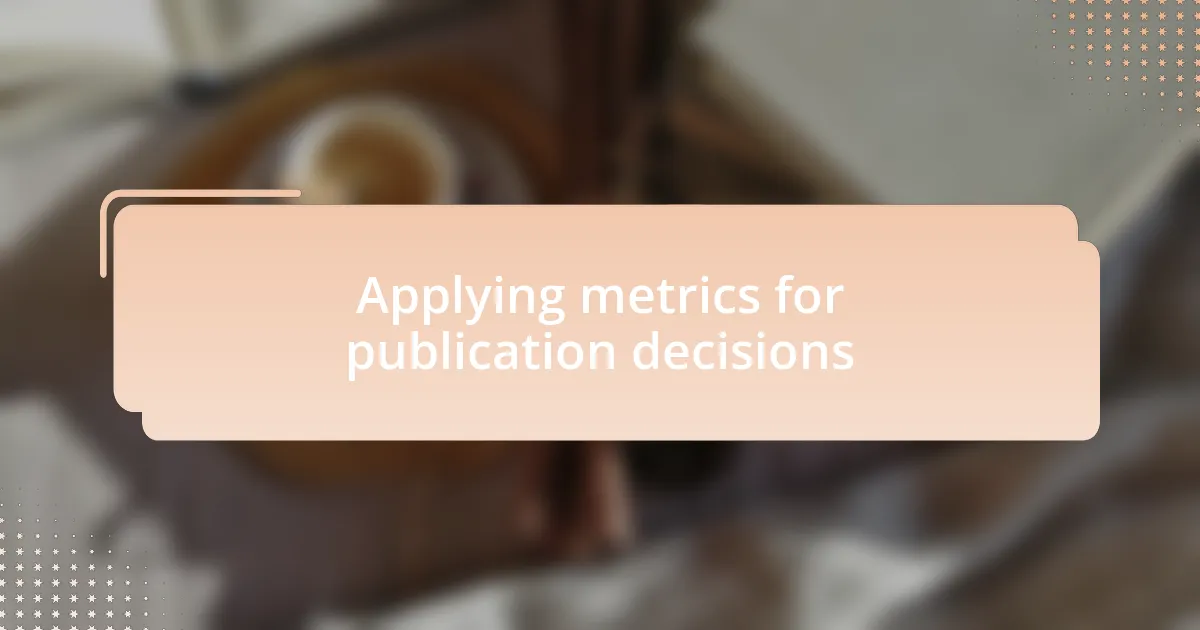
Applying metrics for publication decisions
Metrics can be incredibly helpful in making publication decisions, but I’ve learned that they should serve as a guide rather than the final word. When I reviewed submission metrics, it became clear that those numbers don’t always reflect the journal’s true influence or relevance. It struck me—how many innovative ideas go unnoticed simply because they don’t fit within traditional metrics?
I recall a time when I grappled with a decision over two potential journals for my work. One had a higher impact factor, but the other showed a vibrant engagement with emerging topics in my field. Ultimately, I chose the latter because I felt my research would generate meaningful discussions there. This experience reinforced my belief that metrics must be balanced with a journal’s unique character and audience.
In my quest to refine my publication choices, I also began assessing metrics through a collaborative lens. I remember discussing publication strategies with colleagues, and we often found ourselves relying on shared insights rather than just raw data. This collaboration helped me see how community perceptions and discussions can shape a journal’s standing, prompting me to ask: Shouldn’t we value those voices just as much as the numbers?